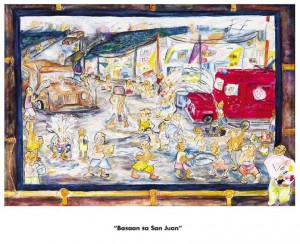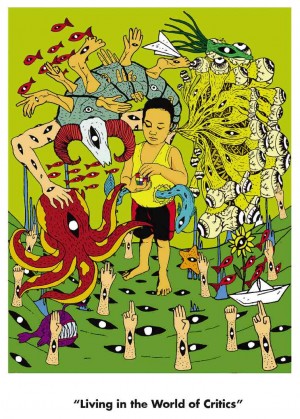
Some 1,000 entries from 40 art schools nationwide were submitted to the 46th Shell National Student Art Competition this year, evincing the continuing vibrancy of the art scene.
In a recent press conference at Ayala Museum, where the winning works are on exhibit, jurors and the winning artists talked about their aesthetics.
Pablo Baen Santos, a juror in the Watercolor category, said that the judges were attracted to works that weren’t “stiff”; they were looking for something fresh and original.
“Art is about enjoyment also. When it’s too rigid, there’s some struggle in the [piece],” Santos said.
Perhaps Santos’ preference for art that is not “too rigid” explains why “Natalo Ako” (which ironically means “I lost”), won the first prize for Oil or Acrylic Painting. It’s a hyperreal depiction of the human heart, as if seen in cardiac surgery. It was by Jay Roque Marquez of the Bulacan State University.
While the subject doesn’t seem sick or, worse, deceased, it may beg the question: What’s wrong with it? Why is it open as if it were undergoing surgery? It invites the audience to offer answers.
Painting and sculpture

Second-placer is “In Loving Memory,” by Alfredo Baluyot from Tarlac State University. This depicts a skull set against a maroon background; it almost looks as if it were weeping, while the world behind it is also crying. It’s a mournful work.
The third-placer, “Protracted Risk,” by David Ryan Viray from Far Eastern University (FEU), is an abstract piece dominated by gray; save for a few splotches of color, it looks like a spiral sucking the painting, albeit in a slow manner, as suggested by the title. The piece evokes a sense of dissonance and unrest.
Nestor Vinluan, juror in the Oil and Acrylic category, said that the finalists “were not very Manila.”
“It’s good to hear that there’s something happening in Tarlac [and] Bulacan. The winners are [scattered],” Vinluan said.
In the Watercolor category, first prize was won by “Basaan sa San Juan,” by Clint Rey Policarpio from University of the East (UE)-Caloocan, which tells the multiple narratives of people wetting each other in the San Juan fiesta. Its lively theme and style echo Larry Alcala’s “A Slice of Life,” in which one can see a bird’s-eye-view of what everyone in a scene is doing. It is also self-reflexivity since it is a metawork, as the entire piece is a painting-in-a-painting, with the artist seen at the lower-right-hand portion.
In Sculpture, first place went to Katrina Noelle M. Gosiengfiao for “Bukas na Lata,” another meta-artwork showing a canned good pried open and beside it its contents served—a packed totem of people-like corned beef.
Second place went to “Floating Dreams” by Carlo de Laza, also of UP Diliman; and third place went to “Sinag ng Dapithapon,” by Bret Faustino R. Manalo III, of FEU.
Digital fine arts
In Digital Fine Arts, Kyle Amiel Balagtas from Technological University of the Philippines (TUP) won first prize for “Living in the World of Critics,” a colorful, cartoon-like work showing off the artist’s graphic skills. Judge Mikel Parial likened it to 1970s style art—very flat, but with bright colors.
Two other TUP students—Myra Flor Labor and Catherine Salazar—placed second and third.
The finalists were brought together in an on-the-spot art session with the jurors. They were divided into four groups, each group made to create a work envisioning the Philippines 100 years from now.
Gosiengfiao and De Laza, who won in the Sculpture category, did an abstract painting, showing a crack and a layer of colorful brush strokes.
“From the disordered cracks, the nation should be able to unite itself,” Gosiengfiao said.
Watercolor winners Policarpio, Florentino and Mallari also did a semi-abstract: A mustard-yellow background dominates the canvas. Amid everything, a faint smile can be seen, symbolizing the inherent optimism of Filipinos.
Among the TUP Digital Fine Arts contingent that won, Labor and Salazar did a mixed-media piece, using a photograph of one of the artists in which she was seen covering an eye; they then painted a monochrome likeness of the work and covered it crimson. Beneath it were Philippine indigenous motifs.
In the Philippines’ march toward modernity, Salazar said, we should not forget our ancestry.
Jurors this year were Ral Arrogante, Michael Cacnio and Junyee for Sculpture; Antipas Delotavo, Edgar Doctor and Pablo Baen Santos for Watercolor; Lex Kabigting, Mikel Parial and José Tence Ruiz for Digital Fine Arts; and Gus Albor, Lito Carating, Igan D’Bayan, Rodel Tapaya and Nestor Vinluan for Oil and Acrylic. Gino Bueza helped screen the provincial entries.

